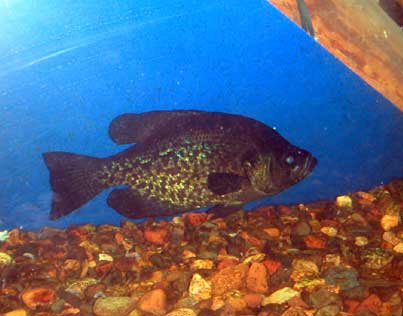Pomoxis nigromaculatus
(Lesueur, 1829)
Black CrappieAlso Known As: Calico Bass, Strawberry Bass, Papermouth, Specks

Above: A Black Crappie in an aquarium. Photo by Dr. Mike Helford.
Etymology:
Genus- Pomoxis= sharp opercle (Greek).
Species- nigromaculatus= black spotted (Latin).
Intro:
The Black Crappie is one of America's best panfish to catch. They put up a good fight, and have a good size to them. This fish, described in 1829 by Lesueur, is easily caught and can be caught in many local ponds, lakes, and rivers.Distribution:
This fish likes a wide variety of habitats, and is associated with structure under the water. This fish can usually be caught over fallen logs in the water, and weed beds. This fish is found throughout the United States.Spawning:
Black Crappies spawn in May and June. They tend to build nest in shallow water around stones or gravel.Diet:
Calico Bass will eat insects, insect larvae, worms, and small fishes.
Size:
Black Crappies usually are 6-12 inches, but occasionally a lunker of 15-18 inches can be caught, weighing about 2-3 pounds.
Keeping In Aquaria:
I don't know much about if this fish has been bred in aquariums, but I know it has been kept as pets. They tend to only accept live foods.
Gaming Qualities:
Black Crappies are great fighters for their size. They really have some muscle in them, and are fun to catch, especially on ultra-light gear.Fishing Tips:
I use 4-6 lb. test for most of my panfish rods. This fish can easily be caught using worms and small minnows, and will occasionally hit a plastic lure.
